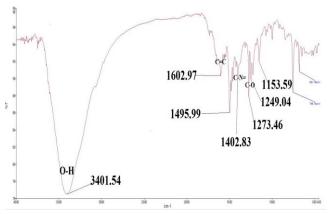Synthesis and Characterization of 4-phenyldiazenylnaphthalen-1-ol as a Sensitizer for Dye-Sensitized Solar Cells (DSSCS)
Keywords:
Azo dyes, DSSC, sensitizers, recrystallization, characterization, solar energyAbstract
The focus of this research is to synthesize and characterize 4-phenyldiazenylnapthalen-1-ol and analyse its optical properties as a sensitizer in Dye-Sensitized Solar Cells (DSSCs). The compound was synthesized and purified by recrystallization. The compound was characterized by an electrothermal melting point apparatus, TLC, UV-Vis Spectroscopy, and Fourier Transform Infrared Spectrometry. The results of the instrumentational analysis of the synthesized compound was compared to that of the industrial standard, inorganic ruthenizer 535-bisTBA (N719) dye. The optical band gap of 4-phenyldiazenylnapthalen-1-ol was calculated as 1.95 eV as compared to the literature value of 1.91 eV of the standard N719 dye. The IR spectrum of the compound also showed an indication for N=N stretch for azo bond at 1465 cm–1. Comparing IR spectra of 4-phenyldiazenylnaphthalen-1-ol to that of the standard N719 dye, the presence of OH group strong signal around 3326 cm–1 is necessary as a feature for dye sensitizers having good anchorage to the TiO2 surface for better device performance.
References
H. Zollinger, Color Chemistry. Synthesis, Properties and Applications of Organic Dyes and Pigments, 3rd Ed., pp. 144-146, 2003
Franciscon E, Zille A, Dias G. F , Ragagnin C., Durrant Lucia R. , Cavaco-Paulo A. Biodegradation of textile azo dyes by a facultative Staphylococcus arlettae strain VN-11 using a sequential microaerophilic/aerobic process . International journal of Biodeterioration & Biodegradation Vol 63 pp. 280–288, 2009
Chakraborty, S., Chowdhury, S. & Das Saha, P. Biosorption of hazardous textile dyes from aqueous solutions by hen feathers: Batch and column studies. Korean J. Chem. Eng. Vol 29, pp. 1567–1576 , 2012
Jaato,N. B. Isolation And Characterization Of Natural Dyes For Application In Dye-sensitized Solar Cells (DSSCs).Submitted Mphil Thesis To University Of Ghana Chemistry Department, legon- Ghana, pp. 48-50, 2017
Filarowski, Resonance, Vol 15 No. 9, 850-855 , 2010
G. Pavlovic, L. Racane, H. Cicak, V.T. Kulenovic, Dyes and Pigments Vol 833, 354-362, 2009
H. Zollinger, Color Chemistry. Synthesis, Properties and Applications of Organic Dyes and Pigments, 3rd Ed.,pp 144-146 , 2003
Fieser,Louis F. and Fiese M.Organic chemistry, 3rd edition.Reinhold publishing corp:New York, pp.571-1036, 1956
Louis B. Size, Dimensionality, and Strong Electron Correlation in Nanoscience Acc. Chem. Resonance. , Vol 47 No. 10, 2951–2959, 2014
Eaton, W.A.; Hofrichter, J. Polarized absorption and linear dichroism spectroscopy of hemoglobin. Methods Enzymol ,Vol 76, pp. 175–261, 1981
Yanhu, K.L.; Yao, W.J.; Luo, Y. Origin of the Q-band splitting in the absorption spectra of aluminum phthalocyanine chloride. Chemical Physics. Letters. Vol 438, 36-40, 2007
Mandal, S., & Bhattacharya, S. UV-vis and Ftir Spectroscopic Analysis of Phytochemicals and Functional Group in Ocimum Sanctum and a Few Medicinal Plants. Rom. J. Biopys, Vol 25 No.4,pp. 8-12, 2015

Downloads
Published
How to Cite
Issue
Section
License

This work is licensed under a Creative Commons Attribution 4.0 International License.
Authors contributing to this journal agree to publish their articles under the Creative Commons Attribution 4.0 International License, allowing third parties to share their work (copy, distribute, transmit) and to adapt it, under the condition that the authors are given credit and that in the event of reuse or distribution, the terms of this license are made clear.





